Day 1 of a weekend of Autumn Tours today. It was a wet and windy day, with a cold and gusty northerly bringing squally showers in off the North Sea. Perfect seawatching weather – but we had a few other things we wanted to try to do today as well.
With seawatching in mind, we made our way over to Sheringham first thing. It was a big tide this morning and with the strong north wind, the waves were crashing over the prom. It meant we couldn’t get along the prom to the shelter, so we had to drive round to the other side, and it also meant there were already a lot of people taking shelter here. We managed to find a spot out of the wind and settled in to scan the sea.
It was immediately clear there was a lot of wildfowl moving this morning, birds arriving from the continent, coming in over the North Sea to spend the winter here. We saw a steady stream of flocks of Wigeon and Teal flying past, mostly low over the waves. A couple of groups of Common Scoter coming past further out, and then some flew through with a group of Teal, providing a nice size and colour contrast.
The Brent Geese are arriving for the winter too at the moment, flying in short lines, and there were a small number of Shelducks, sometimes mixed in with them. Two Goldeneye flying past were the wildfowl highlight.
There was a steady movement of commoner seabirds passing by this morning too – mostly Gannets, Kittiwakes and Guillemots, blown inshore by the wind. Two dark juvenile Arctic Skuas came through reasonably close and disappeared off east. A single Manx Shearwater was too far out for everyone to get onto. A Great Northern Diver flew west, typically flying strongly well above the waves, despite the wind. But there was no sign of any Pomarine Skuas or Little Auks while we were watching, which we had thought we might see this morning.
There are always a small number of Purple Sandpipers along the shoreline here through the winter and a much larger number of Turnstones. The Turnstones will often run along the prom but the Purple Sandpipers are normally down on the rocks below. However, the crashing waves were obviously too much even for the hardy Purple Sandpiper today, and a couple of times it was pushed up onto the prom in front of us. When it flew back down onto the rocks, we had a good look at it over the railings.

We only spent an hour seawatching this morning, then with other things we wanted to try to see, we decided to move on. As we drove west along the coast road, we could see a large flock of Pink-footed Geese in a stubble field. We found somewhere to pull in and would down the windows. The geese nearest us flew up and settled again towards the back of the field, out of view, but it was clear we couldn’t get out of the car without flushing the rest of the flock. We could still see quite a few geese from the car, but most of them were hidden now in a dip in the field.
There were several Red-legged Partridges feeding in the stubble too, and we heard Skylarks calling as we opened the windows. A couple of smart Yellowhammers perched in the hedge nearby, calling..
Continuing on to Salthouse, we parked by the duck pond. As we got out of the car, a Woodcock shot past. It felt like it might almost have crashed into us, but veered round, over the road and into the gardens beyond. Another bird arriving from the winter, possibly from as far away as Russia, presumably fresh in and looking for somewhere sheltered to rest. Several Black-tailed Godwits were standing around in the pools behind the duck pond.
There has been an ‘Eastern’ Stonechat here for the last week or so, which we were keen to see. As we walked down along the track, we could see quite a crowd gathered already, but they didn’t seem to be looking at anything in particular, mostly standing around chatting. Apparently the Stonechat had not been seen for the last 15 minutes – it was clearly keeping down out of the wind today.
We walked up to where it had last been seen and scanned the edge of the grazing marsh, but couldn’t see any sign of it. Then we walked back to where it had been favouring in previous days, out from one of the field gates. It wasn’t out there either, but scanning back along the reedy ditch which runs beside the path, we spotted the Stonechat down in the vegetation.
It was obviously more sheltered down in the ditch but you could only see the Stonechat looking back from the gate and it kept disappearing into the reeds. When it did finally venture out onto the edge of the grazing marsh where it was more visible, a Sparrowhawk promptly appeared just beyond it, flying out low over the grass. The Stonechat sensibly dived back into the reeds, but then went made its way further back along the ditch away from us, where we couldn’t see it.
About half the group had managed to see the Stonechat, but there was a big crowd by the gate so not everyone had got onto it. Climbing up onto the top of the bank, we walked along level with where it had been. After a few minutes scanning, we spotted it again out in the middle of the grazing marsh this time.
The Stonechat was well camouflaged against the dead sedges, shades of orange and brown. But the wind seemed to have dropped, and it became more active, perching up on the top of the vegetation like a good Stonechat should! Finally, we all got nice views of it through the scope.
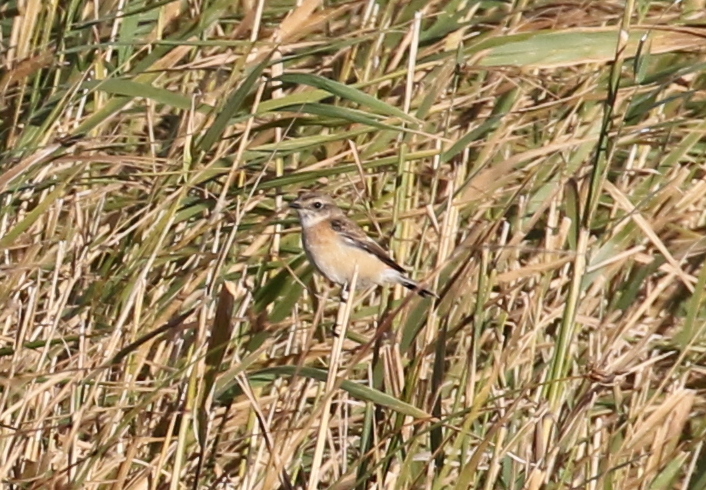
‘Eastern’ Stonechat is the name currently being used for a group of species, including Siberian and Stejneger’s Stonechats, both of which can turn up here. It used to be much simpler, as they were all lumped together under the title ‘Siberian’, but DNA analysis has shown Stejneger’s to be distinct from Siberian and it is now treated as a full species in its own right. Unfortunately, our ability to identify these birds in the field has not kept up with the pace of taxonomic change driven by genetics!
The Salthouse Stonechat appears to be a Stejneger’s Stonechat – at least it looks similar to Stejneger’s Stonechats which have been confirmed by DNA testing recently. Hopefully, DNA has been collected and will be able to confirm it’s identity. If it is not Stejneger’s, then it will be back to the drawing board with the ID criteria!
Either way, it is an interesting and well travelled bird. ‘Eastern’ Stonechats breed across Russia to Japan and China, mostly wintering on the Indian subcontinent, with the range of Stejneger’s being further east than Siberian.
Once we had all enjoyed good views of the Stonechat, we drove on to Cley and stopped at the Visitor’s Centre for an early lunch. There were lots of birds on the scrapes and, with the wind having dropped a bit, we could even eat at the picnic tables overlooking the reserve.
A Marsh Harrier drifted across the scrapes, causing a mass panic, flushing lots of Black-tailed Godwit and Wigeon. Thankfully, as it drifted off, the birds all seemed to settle back down. Two Lesser Redpoll flew over calling and eight Golden Plover circled over. The surprise here was a Gannet circling over the fields behind the Visitor Centre, presumably blown inland on the wind.
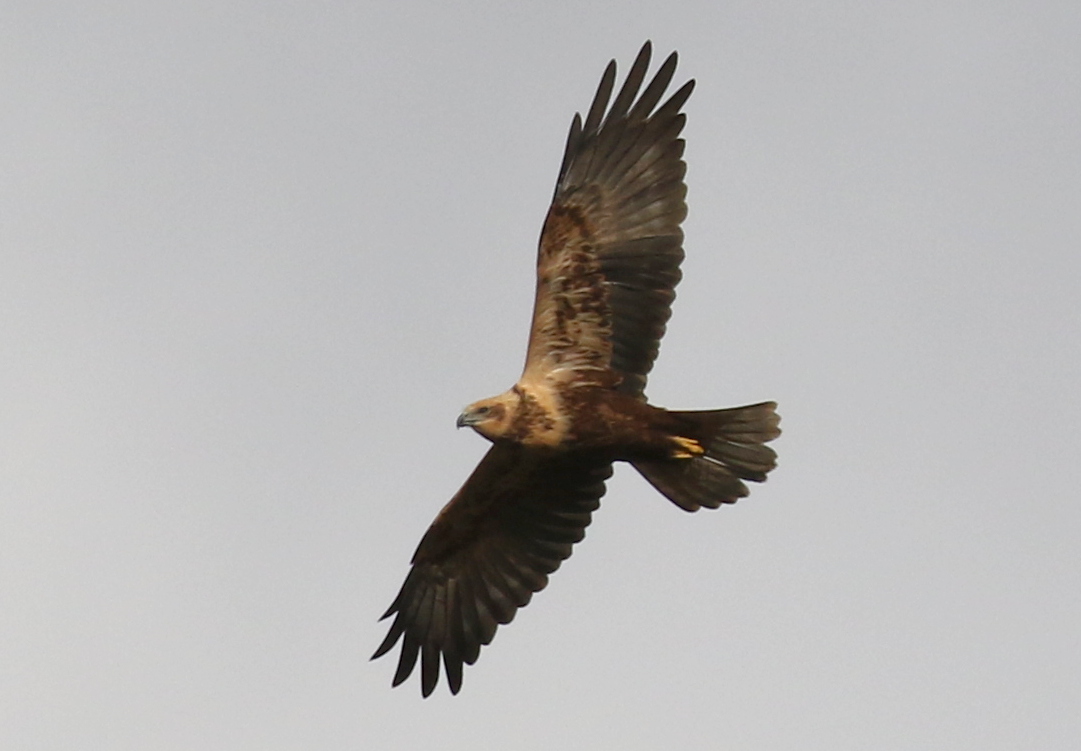
After lunch, we could see black clouds approaching from the north, so we decided to head out to the hides, where we could get some shelter. As we walked along the Skirts path, a Spoonbill flew past over the reserve. Most of the Spoonbills which spent the summer here have departed now, with many of them heading down to Poole Harbour for the winter. There are only one or two still lingering on, so it was nice to see one today. It circled over the scrapes and looked like it might land, but then continue on east.
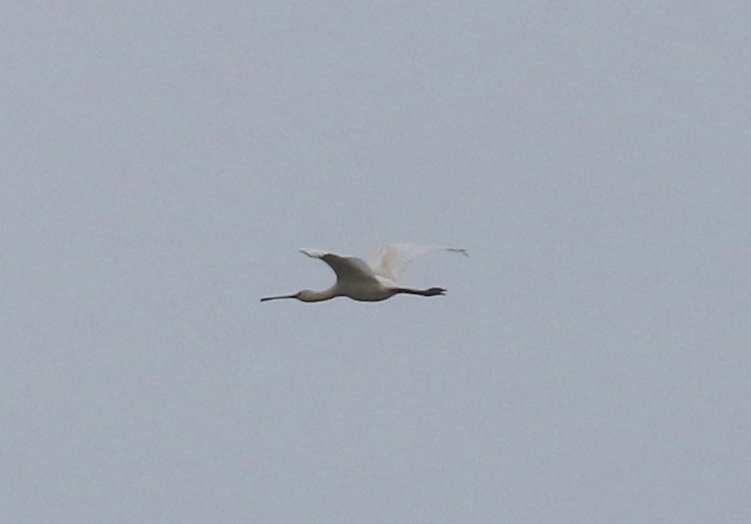
By the time we got out to Dauke’s Hide and looked out, we were surprised by the comparative lack of birds, particularly compared to the masses we had seen when we were eating lunch. Talking to one of the volunteers in the hide, it seems the Marsh Harriers had made several more passes over the scrapes and eventually succeeded in scaring off most of the birds. We could still see a couple of Marsh Harriers quartering the reedbed in the distance.
There were still a few waders left. A couple of little groups of Dunlin were picking around on the muddy edges of the islands. Several Black-tailed Godwits were feeding in the deeper water. The Lapwing were mostly asleep on the grass and a lone Avocet was standing in the water behind one of the islands. Like the Spoonbills, most of the Avocets have gone south now for the winter, but a very small number always try to remain as long as it doesn’t get too cold. A Common Snipe dropped in at back, but quickly disappeared into grass.
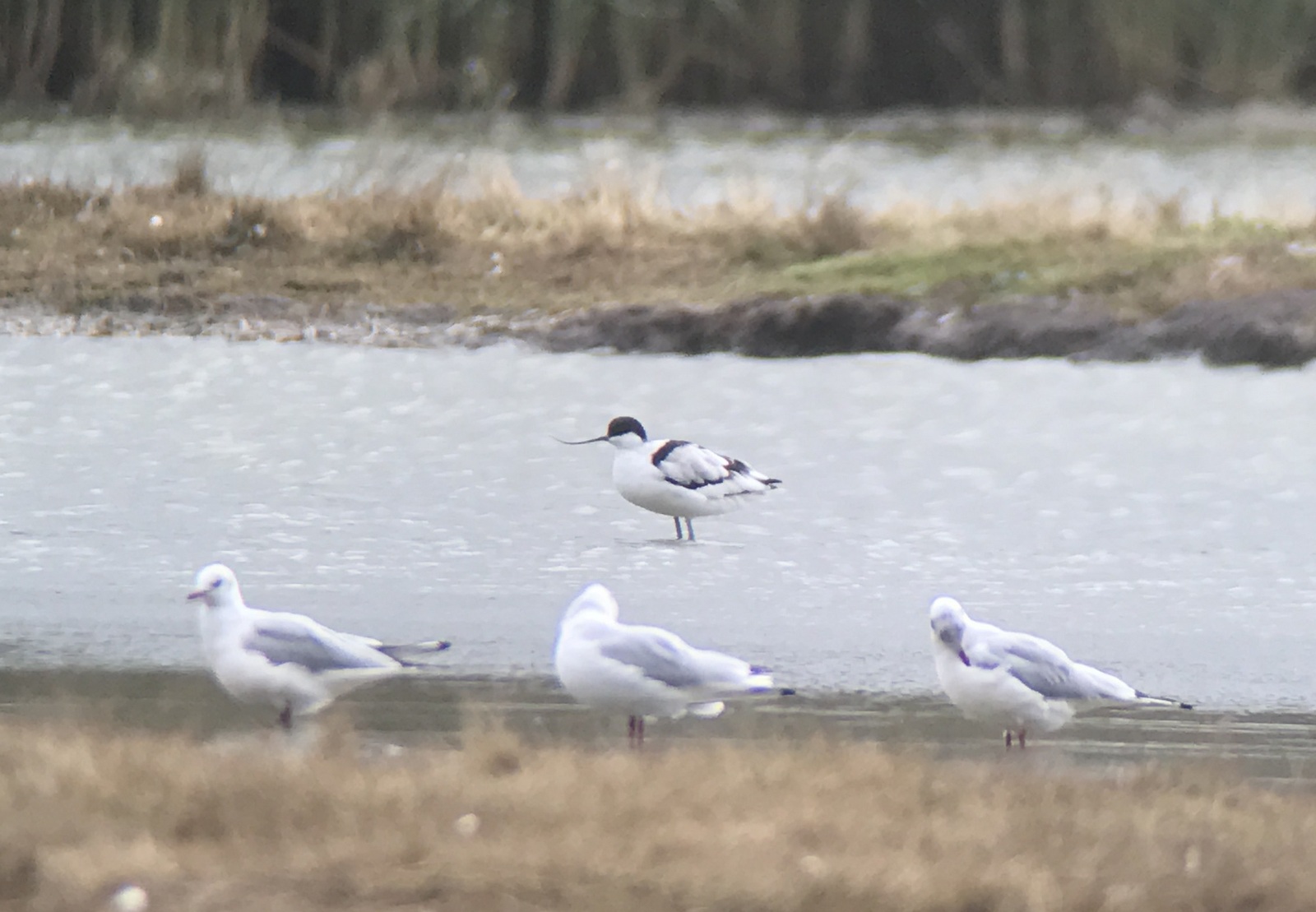
There were still a few ducks left on the scrapes too, mainly Wigeon and Teal, along with a few Shelduck. The Black-headed Gulls were joined by a couple of Common Gulls and a single Lesser Black-backed Gull was asleep on one of the grassy islands. The Spoonbill came back west and headed off towards Blakeney Harbour.
While we were in the hide, it started to rain, so we stayed in the dry until it eventually eased. Then we headed back to the car, and drove round to the East Bank car park. As we got a short distance up the bank, it started to sleet, so heads down, we walked quickly up to the shelter overlooking Arnold’s Marsh.
The forecast was for heavy showers, but the weather seemed to set in for a while now. There was lots of water already on Arnold’s Marsh, which was good for the ducks, presumably with many coming over here when they were flushed from the scrapes. There were lots of Wigeon and Teal again, but with a few Shoveler here too. Scanning through carefully, we found a female Pintail and four Gadwall in with them. A group of Brent Geese dropped in, possibly fresh arrivals stopping for a rest. With the high water levels, the Black-tailed Godwits were feeding in the tall vegetation around the edges.
We had been told about two Snow Buntings feeding at the end of the bank, by the beach. When the rain finally eased again, we walked up to look for them but as we arrived we could see two walkers had just come up off the beach and gone right through the area. There was no sign of any Snow Buntings, presumably having been flushed.
We set off east along the grassy part of the old shingle ridge, but there was no sign of them along here. When we got back to the East Bank, the Snow Buntings flew up from the shingle ahead of us, presumably having flown back in. They landed back on the north end of the path just a few metres ahead of us and we had nice views of them as they fed on amongst the stones, picking around the clusters of vegetation. They were looking a bit bedraggled, but we were probably too!
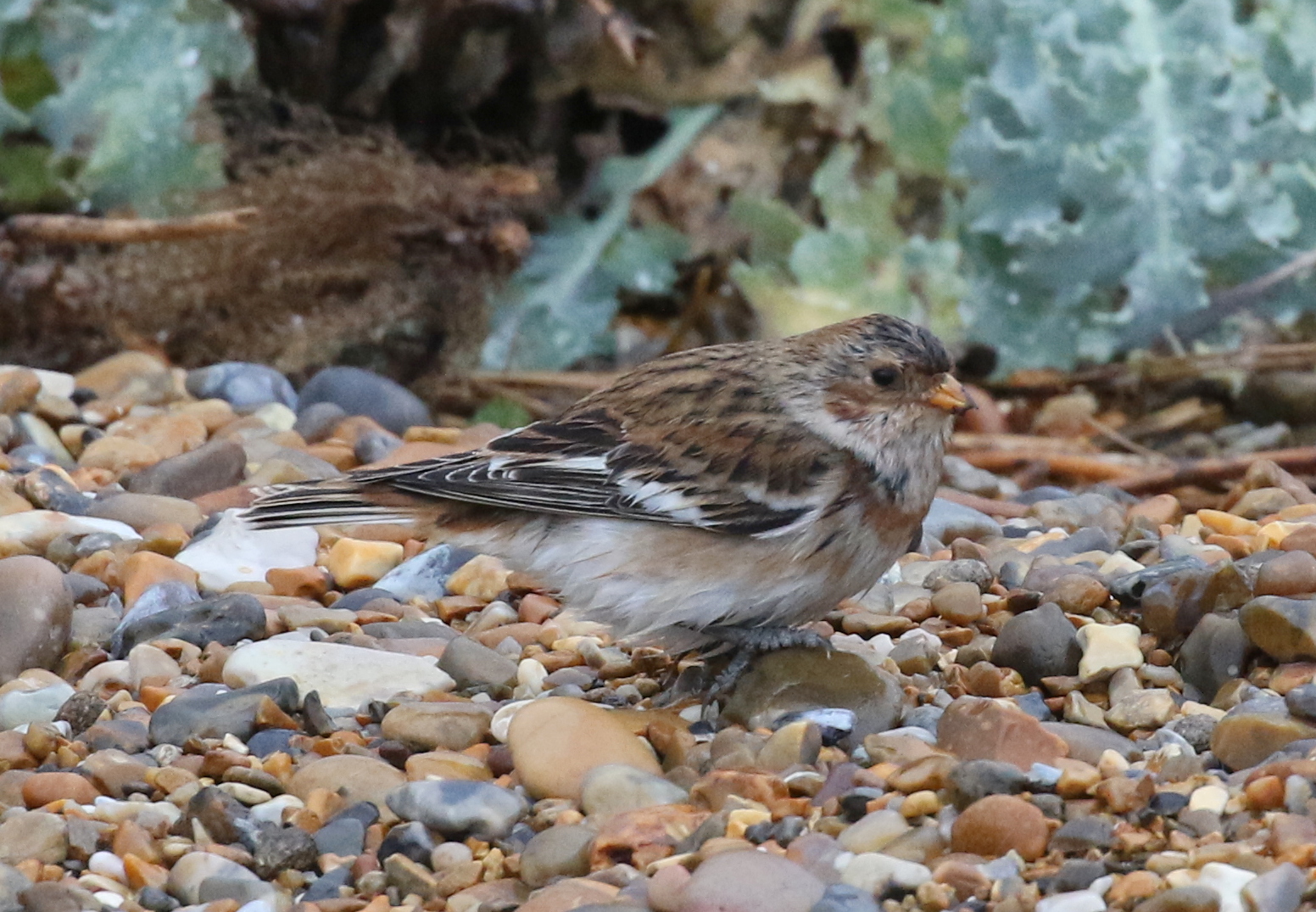
While we were watching the Snow Buntings, we noticed a large dark bird drifting west right past us, with the gulls over the beach. It was a Pomarine Skua. We watched it as it hung in the wind – we could see it was heavy, bulky, especially compared the Arctic Skuas we had seen earlier. It landed on the beach and we could just about see it in the scope from here through the sea spray, so we walked over for a closer look.
After we had all had a good look at the Pomarine Skua in the scope, it took off and flew further west again. It looked like it went down towards the beach car park, so we decided to head back to the car and drive round there to see if we could find it again.
As we walked back along the East Bank, we could hear Pink-footed Geese calling and looked up to see a small skein coming in from the east. They came in overhead and dropped down towards the reserve. Four Marsh Harriers were already gathering to roost out over the reeds.

By the time we got round to the beach car park at Cley, the Pomarine Skua had taken off and gone further west again. Looking out to sea, there were still lots of Kittiwakes & and Gannets pouring past. Lines of Brent Geese were still moving west offshore too.
We were just about to leave when someone seawatching there shouted that there were two Little Auks on the sea. They were in the surf just offshore, drifting west towards us, but despite being close they were still hard to see in the crashing waves. We managed to get the scope on them, and you could see them as they rode up the face of the waves.
They seemed to swim a bit further out and we lost sight of the Little Auks. Then we noticed a Great Black-backed Gull drop down into the breakers, followed by three more. When they came up again, one of them was carrying a Little Auk in its bill! We didn’t see what happened to the second one, but Little Auks are always vulnerable when they are blown in by gales. They breed in the Arctic and spend the rest of their lives far out at sea, away from predators like gulls. They are often exhausted when they are close inshore and easy pickings for the gulls.
That was a fairly gruesome end to our seawatching today – nature red in tooth and claw! We still had one more stop to make on our way back. With the blustery wind and rain, the Peregrine was in its usual spot on the sheltered side of the church tower, tucked in an alcove between the stone pillars. We stopped and had a nice look at it through the scope.
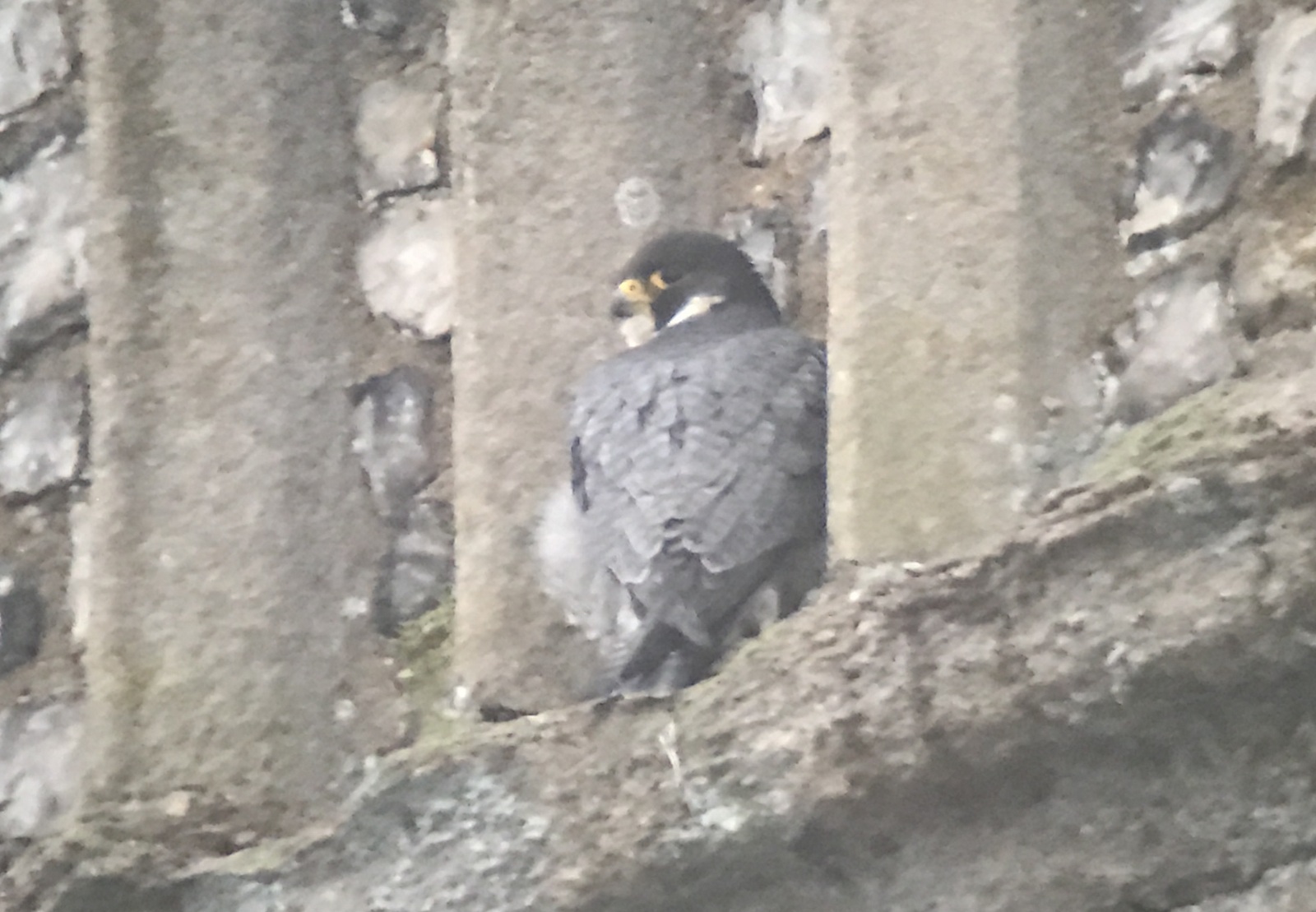
We had done well today, despite the wind and rain. The weather forecast is a bit better for tomorrow, so let’s see what the wind had brought us!
















